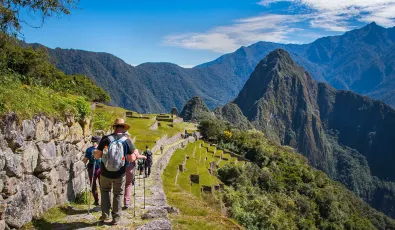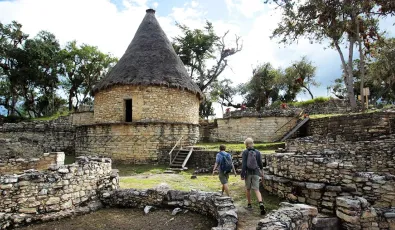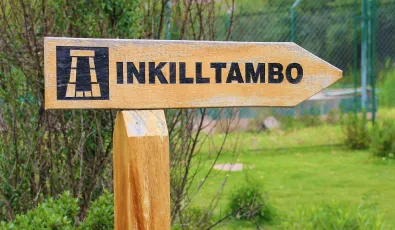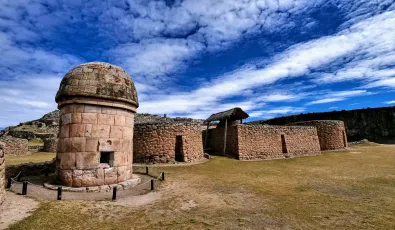The archaeological zone of Kanamarka is located in a basin with gentle relief, surrounded by protective Apus like P'usuqiña, Inkapirwa, P'uyamarca, and other Apus, rooted in religious patterns. It served as a religious administrative center, featuring architectural structures such as Qolqas and Kallankas, residential enclosures of circular, rectangular, and square shapes, ceremonial worship spaces, pre-Hispanic channels, terraced platform walls, and paths.
K'anamarka has been continuously inhabited from local settlements through the Inca and colonial periods, exemplified by a colonial church or temple. It is noteworthy that burials from funeral contexts were found within these structures, indicating the ideological practices the K'anas performed as a connection to their ancestors.
Where is it located?
The archaeological zone of K'anamarka is situated in the community of Chani K'anamarca in the district of Alto Pichigua, Espinar province, Cusco department. It is 15 km northeast of the capital of Yauri, at an altitude of 4050 meters above sea level, and spans a total area of 44 hectares.
Kanamarca: Meaning of its name
The term K'anamara etymologically stems from the combination of two Aymara words: "K'ana" meaning braided, and "Marca" meaning town, which translates to "Braided Town or town intertwined with ropes" with respect to the history of the Qollas territory. The original indigenous name for the inhabitants of Canas is K'ana.
On another note, researchers indicate that "Qana" also means "light, clarity, luminosity" and "Marka" means "place," together meaning "Resplendent Place."
What's the history behind Kanamarca?
Pre-Inca Era
During the pre-ceramic period, Espinar was inhabited by the man of Yauri, the region's oldest man, settling in Chisipata, Trapichepampa, and Yuthu, dating back 5,000 years BC. They dwelled in caves and rocky outcrops, as evidenced by the remains of rock paintings depicting scenes of camelid rearing, from which the ancient K'ana nation spread.
The K'ana nation was composed of several human settlements, including Pichiwas, Koporaquis, Languis, Qewes Pampamarkas, Ayawiras, Choquepiqllo, and Cavanas. The capital would have been located in Hatun K'ana, currently the district of Pichigua.
The Great Land of the K'anas
The K'anas, consisting of four main ayllus—K'anas, Qanchis, Ayaviris, and Cabiñas—had significant influence from the Wari and Tiahuanaku cultures. After the decline of the Wari culture, the Pichiwa territory and other ethnic groups were linked to the regional K'ana state. The K'anas, an Aymara ethnicity whose language was "Aymara or Haque-anu," had their administrative capital in K'anamarca and their main ceremonial center or waca in Ancocagua or Hanccoccahua in Coporaque.
Inka Era
In the Inka era, the K'ana nation became part of the Tawantinsuyo, as a result of a confederation with the Incas, called K'ana Wamani or K'ana Nation. When the Canas and Incas united, the Inka appeared in Lurucahi where he conveyed a message to the K'ana leaders about rising together as a nation, ordering his warriors not to be bold in entering their homes, nor to steal, or do anything harmful and requested to be honored with their presence at the celebration at the guaca of Aconcagua to whom they should give thanks. The respectful Canas attended the ceremony as special guests, receiving gifts of jewels and fine wool clothes, thus peacefully incorporating and submitting to the Inka society, complying with the directives issued in political, economic, religious, administrative, and social aspects.
Colonial Era
During the colonial era, after the Spanish conquest, a new type of organization was introduced in the Tahuantinsuyo, the “encomiendas” and “corregimientos”. The curacies of Pichigua, Yauri, Coporaque, and Ankonkagua belonged to the corregimiento of Canas of Orcosuyo, being the most important curacies of Pichigua and Yauri. Upon establishing Pichigua as a curacy of Canas, in its beginnings, it corresponded to the Hanansaya sector composed of four ayllus Camanoca, Cavaycollana, Antacolla, and Curimama, as well as the Urinsaya between 1647- 1657. Each of these towns, in the process of reductions, was consolidated into large ayllus, as a basic unit of social organization based on reciprocity and land redistribution. The natives were subjected to forced labor without political and civil rights, establishing doctrines of tax payments, and forced to provide labor without compensation, leading some indigenous people to migrate to different places and others to be subjected to forced labor, some exploited in the mines.
Why are they considered a warrior people?
Currently, the population of Espinar is recognized as a "battle-hardened people" known as the K’anas, described as the proud land of K'ana, valiant and brave fighters who have preserved their rebellious and warrior spirit throughout their history. K’anamarca epitomizes the history of the Kanas at its peak, today known as the second Machu Picchu of Espinar due to its monumental architecture, making it the most famous tourist attraction in all of Espinar, visited by tourists coming from the direction of Arequipa.
The Archaeological Site
The archaeological zone of K’anamarka includes architectural structures, enclosures of circular, rectangular, and square layouts of various sizes, with trapezoidal access doors and niches of various dimensions within its walls, all distributed within an urban planning scheme. The wall construction technique is of rustic masonry, ordinary and arranged, with lithic elements of volcanic type, and both the internal and external paraments were covered with mortar or mud plaster. The circular structures have diameters ranging from 11 m to 5.5 m and feature a single access point.
According to archaeological research, K’anamarka exhibits patterns of burials within its structures, which are associated with ceramics.
What to see in the Town of K’anamarca
1. Main Temple of K’anamarca
It is located in the Tupac Yupanqui sector and corresponds to the colonial Christian temple, the largest enclosure in the entire archaeological area. This enclosure has two access openings, one of which is walled up, and windows elevated in a trapezoidal shape, with some protruding elements on both walls. This structure likely served to house the bodies of the most important characters of the K’ana elite, which is why the colonial temple was built in this location.
2. The Kallankas
These are rectangular structures measuring 15 to 20 meters in length and 8 to 10 meters in width, with gables measuring 6 to 9 meters in height. They are spaces for multifunctional, social, religious, and political use.
3. Residential Buildings
These are structures of circular and rectangular layouts that serve the social function of domestic dwellings and workshops, where individuals lived and carried out their activities.
Funerary Contexts
A large number of funerary contexts have been found within the enclosures, one of the most significant discoveries being a funerary context in one of the circular enclosures, the famous Lady of K’anamarca, and other contexts of great importance.
Amazing Discoveries
The Lady of K’anamarca
Discovered by archaeologist Marco del Pezo in 2004, it was the most significant find corresponding to an important character of the K’ana elite, possibly a priestess, called the Lady of K’anamarca, located in a religious area. The associated finds include ceramic objects, two metal tupus, and red spondylus shell necklace beads. Alongside this funerary context, another context was found corresponding to an infant in a poor conservation state, without any associates.
Above this context, another context called the guardian or caretaker was found, presenting a cranial trepanation in one of the parietal bones, indicating that the ancient inhabitants of K'anamarca were familiar with medicinal practices of surgical interventions at the level of cranial trepanation. According to studies of forensic anthropology and facial reconstruction, represented in 3D, it was determined that it corresponds to a female individual who, in life, would have been a priestess or character of the K’ana elite.
The Tombs
A large number of funerary contexts have been found within the enclosures, one of the most important discoveries being a funerary context in one of the circular enclosures, the famous Lady of K’anamarca, among other contexts of great importance.
Major events
The K'ana - Inka Confederation
The K’anas and Qanchis formed a very important strategic alliance with the Incas, thereby supporting the Inca army and peacefully affiliating with the elite of the “sinchis” battalion, thus belonging to the Tahuantinsuyo.
The Corregimiento of the K’anas and Qanchis
Following the Spanish conquest, the Tahuantinsuyo was organized into the Viceroyalty of Peru, based on systems of corregimientos. The K’ana territory was under the corregimiento of Cusco called the K’anas - Qanchis corregimiento, with its capital in Tinta, being the largest tributary population of colonial Peru, with more indigenous tributaries paying their tributes. The first Spaniards to arrive in these areas were the Almagrists, who were searching for a lost town of the Incas called “El Dorado,” but upon not finding this enigmatic place, they stayed in these lands due to the presence of mines.
José Gabriel Condorcanqui
He was a curaca of the K´ana towns called Surimana, Tungasuca, and Pampamarca. He adopted the name “Túpac Amaru II” and led the revolution on November 4, 1780.
How to Get to Kanamarca?
- Route Cusco - Sicuani - K’anamarka (Espinar): It is a distance of 236 km southeast of the city of Cusco, via the asphalted road Cusco - Espinar, approximately 4 hours, 15 km before reaching Yauri, a dirt road deviates to the left margin of the main road for 5 km until reaching the archaeological zone.
- Route Yauri—K’anamarka (Espinar): At a distance of 10 km from the capital Yauri of the province of Espinar, via the asphalted road Espinar—Sicuani—Cusco, a dirt road deviates for about 10 minutes on the right margin of the main road.
Best Time to Visit
The best time to visit this magnificent archaeological monument of K’anamarca is during the dry and cold winter season, which begins in May and extends until October. During this season, you can observe a clear sky and monumentality at its maximum expression. However, during the humid summer season from November to mid-April, you can see the monument covered in snow, accompanied by precipitation, with a totally green scenic environment if it does not snow.
Weather
The climate of K’anamarca is cold to dry with seasonal variations due to the altitude and winds present at the site. The annual temperature fluctuates between 0 and 7 ºC, with maximums of 15 ºC between September and April and minimum temperatures of -9 ºC and -25 ºC from May to August.
Flora
The vegetation is typical of the puna and is very sparse. It includes nettles (Urtica dioica), both male and female, q’ello t’ika (Tithonia tubaeformis), sage (Salvia officinalis), dandelion (Taraxacum officinale), ajotillo (Geranium filipes), sillu sillu (Lachemilla pinnata), straw (Stipa ichu), and other species typical of the area.
Fauna
It presents a biodiversity of species from the high Andean zone, such as deer (Hipocamelus anticensis), puma (puma concolor), foxes (Lycalopex culpaeus), and vizcacha (Lagidium viscacia). Birds are the most abundant and varied fauna, with the most representative being pito (colaptes rupicola), pichitanca (Zonotrichia capensis), which is a typical bird, and the jakachu or Andean woodpecker (Colaptes rupicola).
Practical Tips to Visit Kanamarca
What to Bring?
- Carry an identification passport in case of a tourist.
- Bring layers of warm clothing, scarves, gloves, hats, or chullos for the cold and winds. At night, the cold is extremely intense.
- Bring waterproof jackets and rain ponchos in case of rain.
- Bring a camera to capture and record beautiful memories.
Recommendations on site
- To access the site, use the marked path to avoid accidents and have a better tour of the most important places in the area.
- Depending on the season you visit the site, turn off your cell phones and keep them at a safe distance in case of thunder and lightning.
- The conservation and protection of cultural assets require commitment from each one of us, so let's respect every archaeological site we visit.
- Preserving the cultural legacy to keep it alive is everyone's task.
- Respect the traditions and customs that exalt the identity of the K’ana people.
- Conserve the natural ecosystems of flora and fauna.
- Do not lean on or climb the walls, as it causes wear and destruction of the structures.
Other Nearby Sites You Can Visit
Fortaleza de Muyoq Qawa
Located 22 km from the city of Espinar, in a strategic place, “muyoq qawa” means “to see everything around.” This place is considered a fortress. It has three trapezoidal doorways that access the internal part of the complex. There are circular and rectangular enclosures, chullpas, and funerary structures, thus forming a llacta surrounded by walls. It likely had continuous occupation from the pukaras through the K’ana and, finally the Incas.
Archaeological Center of Antaymaka
Located at the top of the hill of the same name, opposite the Tintaya mine, Antaymarka means “My Copper Town,” where rectangular and circular adobe buildings are observed; towards the south are remains of a finely carved stone wall showing a figure of a fox, these constructions served the function of dwellings.
Arco Punku
Located on the north side of the Villa de Acconcunca, it is constituted by a vertical rock approximately 40 meters high. In the central part, it has a space in the shape of an arch; hence, it is called arco punku. It is a natural attraction.
Explore it!
There are no limits to the adventures we can have in K’anamarka. You will find a wonder in the midst of the heights of the Andes, where the cold and winds do not prevent enjoying this beautiful landscape full of beauty and charm. It is what you need to see in this life: a unique legacy of the K’ana nation. Do not think about it anymore; come and join this adventure with us. You have a whole world to explore and nothing to lose.
Additional Resources
- Archaeological research report K’anamaraca by Marco del Pezo Benavides. INC 2004 and 2005.
- Archaeological research report on the archaeological complex of K’anamaraca—Espinar by Bernardo Aparicio, National Institute of Culture (INC).
- Archaeological research project to conserve and valorize the archaeological zone of K’anamaraca. Dirección desconcentrada de Cultura Cusco 2021.
- Alto Pichigua from the provincial municipality of Espinar.
References:
- Del Pezo, M., (2004-2005). Informe de Investigación Arqueológica K’anamaraca, Instituto nacional de cultura (INC).
- Aparicio, B., (2009). Informe de investigación arqueológica del conjunto arqueológico de K’anamaraca - Espinar, Instituto nacional de cultural (INC).
DDC. Proyecto de investigación arqueológica con fines de conservación y puesta en valor de la zona arqueológica de K’anamaraca.







Add new comment